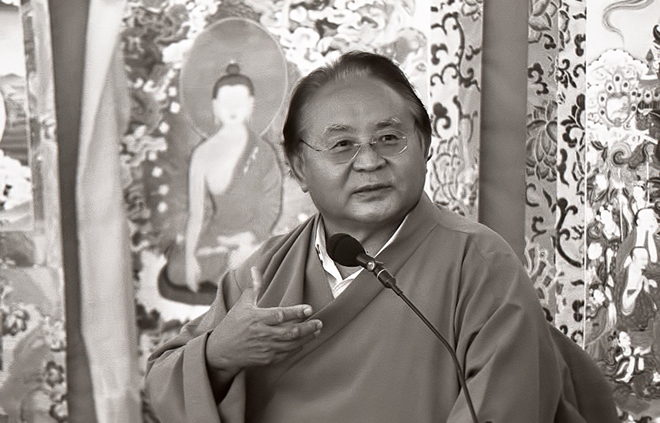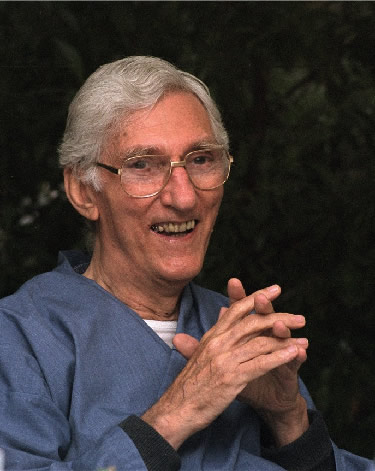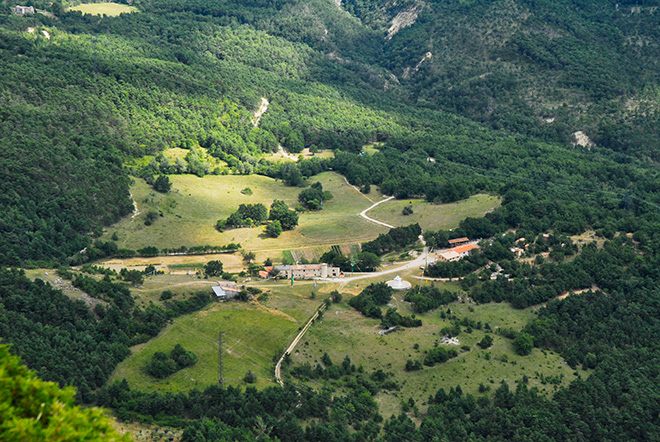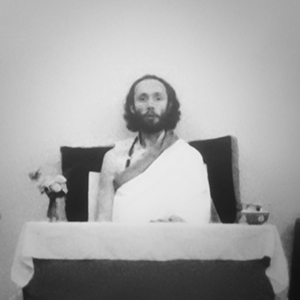Abuse and Buddhism: Behind the Smiling Façade
By Anna Sawerthal
Buddhism in the West is in a crisis. For years, it had benefited from a reputation too good to be true. Only now are victims of sexual abuse¹, corruption and cultic behaviour finally beginning to speak out.
It took years before Ben was even able to kill a mosquito. If he was woken up by a buzzing in the middle of the night, he would drag himself out of bed, find a glass, capture the insect alive and release it out the window. Simultaneously, he might have mumbled a mantra, for example the one attributed to the Buddha of Compassion: om mani padme hum. “True joy can only be found by seeking happiness for others instead of oneself”, “treat every living being as if it was your own mother – even the tiniest insect”: such quotes were simply part of Ben’s system, because he had been raised “buddhistically” – in Nyima Dzong in the south of France. Nyima Dzong is Tibetan and means Sun Castle. That was about it for the Tibetan influence, however. The remainder of what went on in the town was not Buddhist in the least.
Children who grew up there in the 1980’s were punished by being forced to perform 108 prostrations in the snow, or circumambulate the sacred stone barefoot 108 times. If Ben fell asleep during chanting, he would be beaten by the teacher. The children had to do housework seven days a week, and were trained to visualise the guru on top of their heads, in their hearts, in their minds. When Ben was thirteen, he was brought to Portugal, where for four years the youths were trained to be elites, completely shut off from the rest of the world.
The reason was that their guru wanted to prepare the next generation for the coming apocalypse. The daily training regiment in Portugal included karate and 10k runs. The children were forbidden from reading the newspaper; whatever they learned came solely from a couple of teachers. “We built the guru’s house with our own hands”, recalls Ben.
He laughs uncomfortably when he thinks back to the moments when the girls were called into the guru’s new house. “At the time, our only thought was: what do we have to do to get invited in by the guru as well?” Today, Ben knows that he built the house in which his female childhood friends were allegedly abused.
At the time, almost all the kids’ parents were in Brussels, where they worked for free in restaurants that belonged to the OKC. Their guru was a Belgian man named Robert S., who dressed in Tibetan monk’s robes and took up a new name in 1972: Lama Ogyen Kunzang Dorje. This led to the name of the Buddhist group, whose headquarters were in Brussels: Ogyen Kunzang Choling (OKC).
The search for meaning
In the 1970s, thousands of Europeans embarked on a spiritual journey aimed at breaking free from the demands of the old world. They were searching for new ways of living. In Asia and in Europe, they met exotic gurus who gave them new perspectives on life. Unfortunately, some of these gurus were not what they claimed to be. The spiritual seekers turned out to be easy prey for abuse, and only realized it too late – if at all.
Livia was fourteen years old when Robert S. appointed her the sole temple caretaker in Nyima Dzong. She was told that it was a special honour to be able to perform that role. Livia was given a room beside the temple, near Robert S.’s room. She spent her days lighting oil lamps, or shining the golden altar bowls. And at night, she was abused by Robert S.. When the guru took her away over long weekends, none of the adults asked any questions.
In Nyima Dzong, people were indoctrinated to see everything in a positive light. Negative thoughts were said to be signs of a clouded mind. Only Robert S. allegedly had access to ‘true reality’. He quoted Tibetan teachers with whom he had supposedly studied in India. And various Tibetan teachers made him seem legitimate by visiting the OKC over the years, for example the Dalai Lama in 1990. By that time, many instances of sexual abuse had apparently already occurred.
Livia tried to deal with the abuse by meditating. She imagined that her mind was a broad, empty field, “though at the side I pictured a huge rock.” When she was in the field, she was only allowed to think good things about Robert S. and the group. But when she hid behind the rock, she was allowed to think whatever she wanted. Nobody would ever know, and thus she would not generate any bad karma for herself or others. “I know it sounds crazy, but for me it worked,” she says.Not an isolated case
One might think that allegations surrounding OKC constitute a horrible exception, a monument to the failure of entire institutions: family, friends, or the justice system. However, the OKC is unfortunately only an extreme example of a larger problem that has gone essentially unnoticed: abuse in the name of Buddhism. Just off the top of his head, Tenzin Peljor can name nine recent cases in Europe. Born in Germany as Michael Jäckel, Peljor became a Tibetan Buddhist monk in 1998. He says that he initially ended up in a Buddhist cult himself. After a four-year struggle to get out, he has since dedicated himself to promoting an open discussion about similar problems in other Buddhist communities. Three of the groups he can point to are in Germany.
Rob Hogendoorn, a Dutch publicist and long-time Buddhist, is currently following some twenty cases in which Buddhist teachers in the Netherlands have been accused of sexually abusing their students. The country has 39 recognised Buddhist organisations; he claims to have received complaints about almost half of them.
The dam broke in July
Up until now, almost nobody had been talking about these “isolated cases.” Buddhism had too good a reputation, and it would have been too embarrassing to admit that, in this regard at least, the situation was not much rosier than in Christianity. The fact that a discussion is now finally taking place is mainly due to a scandal featuring one of the most famous Tibetan teachers in the West: Sogyal Lakar. Lakar’s book “The Tibetan Book of Living and Dying”, published in 1992, won over the hearts of millions of readers, thus providing him and his international organisation Rigpa with tremendous wealth and power.

© Olivier Riché | Sogyal Lakar Rinpoche teaching in Dzogchen Beara | CC BY-NC 2.0
In July, a letter from eight of Sogyal’s closest disciples was leaked, in which they accused him of severe abuse. “Our wish is to break this veil of secrecy, deception, and deceit,” the former students wrote. They detailed instances of severe physical and psychological violence, and of sexual abuse of women. The letter itself was an act of forceful resistance – after more than twenty years of subjugation for some. The letter claims that Sogyal justified his violence as “wrathful compassion” or “skilful means”, and it repeats several times that the students “no longer believe this to be so.” Since the letter was leaked, blog forums and Facebook groups have come alive with discussions about Buddhism in the West and the relationship between students and teachers.
Oane Bijlsma, a former Rigpa disciple with access to the innermost circle around Sogyal, recalls how the ‘master’ held meetings with his students while sitting on the toilet and defecating. “He does it with the bathroom door open; sitting there stinking and constipated.” He would regularly beat his students, also to unconsciousness, since even though a hug was considered a blessing, being hit was allegedly an even bigger one. “Sogyal really believes this shit,” Oane says. “He really thinks he’s some omnipotent being.”
She got to know the young, beautiful women in Sogyal’s inner circle – who were available to him around the clock – because she almost became one of them herself. She knows that he forced women to strip for him while his male assistant watched. Oane sums up the Rigpa’s inner circle with a bitter comparison: “It is like a dysfunctional, incestuous family with grave sado-masochistic tendencies, but without a safeword.”
Some observers consider Tibetan Buddhism to be particularly susceptible to abuse, because it uses secret practices that are performed in confidence between a teacher and his students. Yet the cases named by Tenzin Peljor and Rob Hogendoorn show that there are similar accusations in all types of Buddhism. For example, in July, a court in Augsburg sentenced the Zen teacher Genpo D. to eight years in prison, after he admitted to having sexually abused seven boys. D. has appealed the conviction for reasons of too high of a sentence.
Overcoming the ego
Buddhism basically identifies the ego as the source of all human suffering: in order to reach enlightenment, we have to overcome our egos. This does not mean, however, that we have to switch off our powers of reasoning. On the contrary, we are supposed to apply our minds to see through to the true nature of all things. In Vajrayana, also known as Tantric Buddhism and mainly practiced in Tibet, there is also another possibility, which allows the student to reach enlightenment particularly quickly using unconventional means. Since these esoteric practices can only be transmitted directly to students, they have to be practiced under the guidance of a teacher. And this is where novice students risk getting pulled completely astray.
The practices used in Tantric Buddhism are strictly ritualised, and may only be taught by teachers who have been specifically authorised beforehand. Ideally, the students themselves must have already undergone many years of in-depth training, in order to be able to put the Vajrayana teachings in their proper context within the Buddhist path.
When a student agrees to work with a guru, she or he is implicitly acknowledging that the guru sees reality as it actually is, whereas she herself only has a false view: such assumptions are in fact asserted as vows. The teacher may use various methods to help the student along her spiritual path. And unless the guru has taken a vow of celibacy, these methods may include sexual practices.
Sex as a means to enlightenment: tantra and dakinis
Sogyal bases himself on his interpretation of Tibetan legends featuring “mad yogis”, who used unconventional tantric methods to reach enlightenment in only one lifetime, and who taught them to others. Livia pleaded with Robert S. numerous times to stop the sexual activity. But he persisted, saying that it was important for her enlightenment, and that otherwise she had no chance of becoming enlightened in this lifetime. When she continued to resist, he began to threaten her. She was made to copy by hand a book about Yeshe Tsogyal – the legendary “consort” of the Tibetan religious figure Padamsambhava. And, according to Tenzin Peljor, in 1995 Sogyal told a woman that having sex with him would help her father, who had recently died, to reach enlightenment.

Sangharakshita (Dennis Lingwood) – Founder of Triratna (formerly known as FWBO)
© Tathaataa | CC BY 3.0
Such claims portray sexual activity as a kind of spiritual test. Students who resist are thus made to feel like they are evidently on the wrong path to enlightenment. Mark Dunlop, a long-time Triratna student, claims in a blog post that his teacher Sangharakshita explained to him the path to enlightenment as follows: “If I was to make spiritual progress, I needed to break through this unconscious anti-homosexual conditioning.” And the way to do that? By having sex with his teacher.
Such teachers often invoke the concept of the “dakini”: angelic beings who supposedly appear as visions to the master, and are allegedly very effective in inspiring men. Sogyal referred to his women as dakinis, and Mark Dunlop was called a “daka”, i.e. a male dakini.
The path of self-denial
“You are really special”, Sogyal once whispered into Oane’s ear. Nowadays she cringes when she thinks about it, but at the time she didn’t know how to respond. She was in a period of personal crisis, and looking for something to cling to. The situation never progressed to the physical with Oane, but for many women it did. According to Tenzin Peljor, “there is a lot of pressure on emotionally needy students, who are looking for healing through care and attention. That leads to their powers of discernment getting slowly whittled away. Step by step, their boundaries are continually breached, until one day the guru says: ‘get undressed’.”
“The voice inside your head screams ‘No! No!’, but at the same time you think: this is a test. If I fail the test, then I won’t be able to get enlightened. Everyone has always told you that you needed it in order to reach enlightenment, and you don’t want to fail. And that pushes you to the point where you accept the abuse.”
Livia told nobody about the abuse. Not only out of shame and demands of secrecy, she says, but also out of fear that she would drop the bomb and nothing would happen. Looking back today, the only way that she can explain the adults’ behaviour was that they were hypnotised. Ben recalls that a girl in Nyima Dzong once talked about having being abused. Yet the adults claimed that her story was just the “visions of an impure mind.” The pressure to comply didn’t only come from above, says Ben: “The real pressure comes from the sides.” Ethnologist Marion Dapsance wrote her doctoral thesis about Rigpa’s fraudulent ways. When she once expressed skepticism about Sogyal’s teachings in a Rigpa discussion group, she was accused of not having a “connection” to him.
“Idealising the perpetrator gives him power. People become willing to do whatever he says”, explains Fatma Altzinger, psychotherapist and contact for sexual violence at the ombudsman’s office of the Austrian Buddhist Union (ÖBR). “The student gives up her sense of self. In group psychology, the phenomenon is explained by strong identification with the leader. Everything that he thinks and does is good. At that point, it becomes impossible to resist him.”
Buddhist fundamentalism: the desire for a leader
After Ben managed to leave OKC, he began working for democratic causes in Brussels. “The OKC is made up of people who give up the control over their lives to serial abusers.” Ben sees the rise of cults and gurus as a sign of the general erosion of democracy. “Everybody slips into this craziness, simply because they stop thinking critically!”
According to ethnologist Dapsance, religion becomes problematic when its myths are applied to reality. Whether it be dakinis, legends, or the ‘apocalypse’: religions portray myths as accepted facts, in order to call ethical principles into question, and sometimes even to break the law. Oane calls this the ‘Harry Potter Syndrome’: our deep desire to believe in unscientific magic. She counts fake news and conspiracy theories into the same category. “I was looking for wisdom, but I found myself faced with this ridiculous man who was acting a lot like Trump. He praises, criticises and insults people in the same way.”
Too good a reputation
Tenzin Peljor says that, unlike Islam for example, Buddhism has a problem not with hate speech, but rather with prejudices that are too positive. He says that Europeans still cling to the myth of a heavenly ‘roof over the world’, populated by enlightened beings presiding over the wisdom of a thousand years.
And people like Sogyal or Robert S. exploit Westerners’ lack of knowledge and fascination with Buddhism, in order to satisfy their own base needs. People who contact Hogendoorn often recount horrific stories and then ask, “Is this normal? Is Buddhism really like that?” He claims that the Buddhist institutions, even those who otherwise do very good work, are not particularly interested in dealing with such cases. “They are scared of having people think that all Buddhists are abusers.” So who ends up being responsible? The guru? The student? The group? The media?
Who is to blame?
In legal terms, the sexual abuse of minors can be easily defined. The situation with adults, on the other hand, is more complicated, since the consent to the sex is “voluntary”. Psychologist Altzinger says: “In the meantime, it has become obvious that we cannot assume that children can give informed consent. But there is a large grey zone for adults.” According to Altzinger, the court decision always comes down to the particular judge, and to how credible the woman’s testimony is.
Tenzin Peljor also points out the legal grey area with regard to homeopathic medicine: “A certified psychotherapist is subject to very clear regulations. He is not allowed to have sex with his patients. In alternative medicine, however, certain things may be considered immoral, but they are not punishable under the law.”
Reactions from Buddhist leaders: the Dalai Lama and Co.
For many students, Buddhist leaders and organisations have been too slow in reacting to Sogyal’s behaviour, if they reacted at all. And some of the reactions have even made the situation worse. Highly regarded Tibetan teachers such as Dzongsar Khyentse or Orgyen Topgyal, for example, have cited ancient legends in order to mitigate the accusations against Sogyal, or even to blame the students for having broken their vows. Though many other teachers have clearly criticised Sogyal’s behaviour.
There is no overarching institution in Buddhism, no “Buddhist pope”. Nevertheless, many people pay particular attention to the Dalai Lama, whose long-time silence on the issue had been considered very problematic. The first accusations against Sogyal were already being made in 1981. In 1994, one female student threatened to sue him, but the case was settled out of court. Despite the many rumours, the Dalai Lama’s foreword continued to be printed in Sogyal’s book for many years. However, in September of this year, HHDL finally stopped mincing words and referred to Sogyal as “disgraced”. “The name of religion has been used as an instrument of exploitation,” he said. And then in late September, he stated that Sogyal had abused his students and that there had been similar cases in Taiwan and Tibet as well.
What happens to the gurus?
After the letter was leaked, Sogyal stepped down as Rigpa’s spiritual director and announced that he was going “on retreat”, i.e. to take some time to meditate intensely. He was most recently seen in Thailand. None of the victims has yet to file legal proceedings against him.
Litigation has been pending against Robert S. in Belgium since Livia and others filed suit in 1997. However, the wheels of the Belgian court system grind slowly, and the group of accusers have been almost helpless against Robert S.’s team of lawyers. Though new accusations have been added to the file over the years, the proceedings only began to really move again in 2015, when Ben took over the reins and began mobilising the various participants. The file contains accusations of over 170 crimes, including kidnapping of children, torture, sexual abuse, fraud, falsification of documents, money laundering, and tax evasion.
In September 2016, Robert S. was convicted in abstentia by a Brussels court in the first instance, and given a four-year suspended sentence. Now 76 years old, he did not appear in court, citing health reasons. He stayed in his villa in Spain and sent eight lawyers in his place, recalls Ben. The accusers were able to pay their lawyer twelve thousand euros thanks to a crowdfunding campaign. Despite the meagre sentence, Robert S. appealed. Almost twenty years have passed since the first claims were filed, and no end is in sight. There is still no news as to when the appeal will be heard.
Ben has had to undergo a long and painful process. He had to break out of the mental prison that he grew up in, and had no opportunities, no money, no social insurance and no basic education. Many former members are in the same position. Any money that they had was donated to the OKC, leaving them with no savings.
Psychotherapist Altzinger states that those harmed can often free themselves by creating a relative context, with the help of other relationships. The victims have to win back a sense of their own boundaries. Oane went into therapy after leaving Rigpa. Livia says that, for her, it was important to have looked Robert S. in the eye in court in 1997. That experience helped her to reinterpret her traumatic childhood experiences, in which Robert S. controlled every aspect of her life. The court litigation since 2016 has changed a lot for Ben, too: “Today, if a mosquito is disturbing my child’s sleep, I’ll kill it. I think to myself: that guy abused hundreds of people. I’m not going to hell for killing a mosquito.” ■
¹ Some names of first-hand testimonials were changed for protection.





